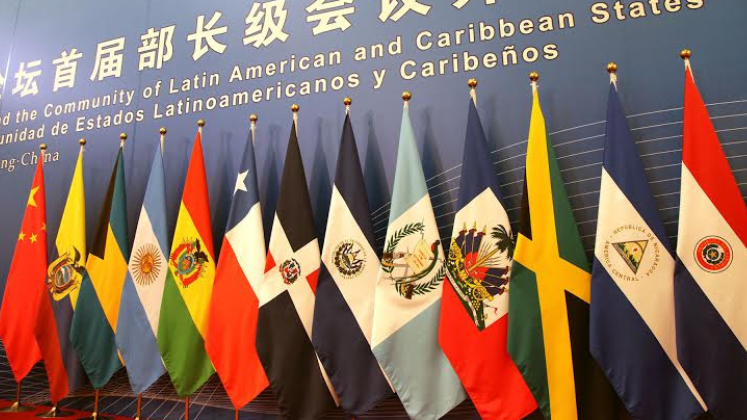Books Feed
Guide Assessment: China and Latin America by Christopher Alden and Álvaro Méndez
China and Latin America: Improvement, Company and Geopolitics. Christopher Alden and Álvaro Méndez. Bloomsbury. 2023.
 Discover this e book (affiliate hyperlink):
Discover this e book (affiliate hyperlink):![]()
From China’s financial reliance on Latin American silver to ‘La Trata Amarilla’, cooperation between the 2 areas was based totally on the alternate of economic, agricultural and mining items. Chinese language immigrants sought employment within the building of canals and railways, sugar plantations, guano and saltpetre mines and different industries within the latter half of the nineteenth century. Chinese language immigrants of the nineteenth century settled in cities corresponding to Lima, Tijuana, Panama Metropolis and Havana, the place they established modest companies that flourished because the group advanced over the following a long time, thus establishing the primary shut approaches between China and Latin America.
China and Latin America: Improvement, Company and Geopolitics, authored by Christopher Alden and Álvaro Méndez, navigates a historic narrative of the relations between China and the Latin American area from their inception to the current. The e book describes the good complexities that each areas have needed to overcome, in addition to how their relationship and social, financial and political dynamics have formed what we are able to now observe as a quickly increasing Chinese language affect within the Western Hemisphere. Furthermore, the authors reveal that when contemplating Sino-Latin American relations, it’s essential to situate the US. The relationships between Latin America, China and the US are characterised by very advanced dynamics.

Picture Credit score: Crop of ‘PRIMERA REUNIÓN MINISTERIAL FORO CELAC CHINA, BEIJING, VISITA OFICIAL CHINA, 08 ENERO 2014’ by Cancillería del Ecuador licensed underneath CC BY SA 2.0
China’s geopolitical relationship with Latin America was negligible for many years. China and Latin America first engaged politically within the Nineteen Sixties in the course of the Chilly Battle’s ideological battle. Because the Chilly Battle divided the communist East from the capitalist West, this led to a succession of navy regimes that supported US pursuits whereas China centered on its home and regional points. As democracy unfold throughout Latin America within the late twentieth century, so did the US’s pragmatic strategy to China. Sources and buying and selling drove China’s entry into the Latin American market.
Upon the institution of the Folks’s Republic of China, the Communist Get together promoted relations with Latin America based mostly on an anti-imperialist cultural and ideological rapprochement. In 1960, underneath Fidel Castro, Cuba was the primary nation within the area to recognise the Folks’s Republic of China. Subsequently, China was in a position to envision a minor shift in its regional projection, shifting from cultural exchanges and partisan diplomacy to a strengthening of progressive political partnerships.
Nonetheless, within the subsequent few years, political relations have been minimal throughout Mao Zedong’s authorities. Later, in 1978, underneath the management of Deng Xiaoping, China launched a reform programme based mostly on the adoption of socialist market ideas, which consisted primarily of two parts: inside adjustment and international opening. On account of this ‘new socialist market financial system’, China’s society witnessed super inside upheaval. China restored diplomatic hyperlinks with a number of Latin American states via its open international coverage. A brand new horizon of diplomatic ties was created and developed into what Alden and Méndez enable us to look at within the e book as one of the fast-growing dynamics in modern politics.
Within the third chapter, the circumstances of Chile, Peru and Argentina are introduced. Chile’s relationship with China has been influenced greater than some other Pacific coast state in Latin America by the broader framework of Asia-Pacific commerce agreements and related actions. Concerning Peru, by reaching out to Beijing and enshrining an financial hyperlink via mechanisms such because the 2009 Peru-China Commerce Settlement, this has introduced a wave of Overseas Direct Investments to Peru’s shores, expanded market alternatives in each nations and sparked a brand new cycle of commodity-driven prosperity.
Within the case of Argentina, the political theatre of adjusting management and political events has obscured the continuity that has served to protect the partnership. Alternatives abound, from middle-class shoppers to strategic assets, and politicians corresponding to former President Mauricio Macri and the Kirchner dynasty have recognised the advantages of Chinese language funding and loans in assets, infrastructure and e-commerce. Chinese language confidence in Argentina’s long-term prospects — echoed to various levels in different areas — signifies a willingness to floor bilateral ties in elite and business relationships.
Subsequently, we’re launched to the Bolivarian republics of Venezuela, Ecuador and Bolivia. The Bolivarian nations, decided to beat their historic reliance on the US, found in China a keen, if cautious, companion. China’s growth of monetary and technological assets in petroleum, constructing and different sectors was used particularly to recoup losses and develop long-term progress potential in these industries. The continual improve in commodity costs allowed these governments to hunt rents from export tax revenue and switch them to financial and social programmes aimed toward historically underserved communities. Beijing’s avowed dedication to non-interference in inside issues ensured that strengthening financial cooperation wouldn’t outcome within the interventionism that accompanies US dependency.
Within the fifth chapter, the authors study the case of Brazil. The nation with the biggest financial system and inhabitants in Latin America has pure assets, a thriving agro-industry, technical prowess in key industries and a big market that has attracted Chinese language firms and monetary assets. The Brazilian-Chinese language partnership is probably the most economically strong, technologically centered and internationally important in Latin America. Beijing established a partnership that displays most of the financial complementarities which have contributed to the expansion of each nations. There was a global push to institutionalise cooperation through the China-Brazil Excessive-Stage Coordination and Cooperation Committee (COSBAN) and different mechanisms, such because the China-Brazil Fund for Enlargement of Manufacturing Capability and the BRICS alliance of Brazil, Russia, India, China and South Africa. This has demonstrated how these alternatives may very well be translated into concrete initiatives at each state-to-state and personal funding ranges, increasing cooperation into new industries past pure assets.
Totally different from the above circumstances, Mexico’s relationship with China exhibits Beijing’s struggles to translate financial energy into tangible outcomes. Mexico’s angle towards the North American Free Commerce Settlement (NAFTA) is the principle cause Chinese language firms have had hassle getting into sectors of the Mexican financial system like railway infrastructure and power. Chinese language competitors is seen as a serious risk to Mexico’s financial standing within the US, which explains its lukewarm response to China’s overtures. Since 2017, Mexico’s coverage towards China modified resulting from President Donald Trump prompting deteriorating diplomatic relations with the US, the US-China commerce conflict and the late realisation that the nation wants to succeed in out to new markets, sources of funding and technological innovation to prosper.
From the attitude of most governments in Latin America and the Caribbean, potential Chinese language growth finance, entry to its market and the arrival of its vacationers have been seen to be a web acquire for his or her economies. The next dismantling of diplomatic recognition of Taiwan in Latin America, which had served as a de facto bulwark of US pursuits, coupled with the escalating surge in Chinese language finance in different nations within the space, was sufficient to warrant a tough have a look at its affect on US strategic pursuits.
As portrayed by Alden and Méndez, the significance of China in Latin America and the Caribbean is turning into more and more tangible and apparent to politicians, teachers, companies and Latin American civil society. In lower than seven a long time after its founding in 1949, the Folks’s Republic of China has change into one of many continent’s main financial and political actors.
This e book affords a complete reflection not solely on the present political context but additionally leads us via the background historical past that has formed the present-day dynamics. Undoubtedly, China and Latin America will likely be an pleasant learn for college students, professionals and most of the people with an curiosity within the advanced modern political points introduced in Alden and Méndez’s examine.
Observe: This evaluation offers the views of the creator, and never the place of the LSE Assessment of Books weblog, or of the London College of Economics and Political Science. The LSE RB weblog might obtain a small fee if you happen to select to make a purchase order via the above Amazon affiliate hyperlink. That is totally impartial of the protection of the e book on LSE Assessment of Books.



